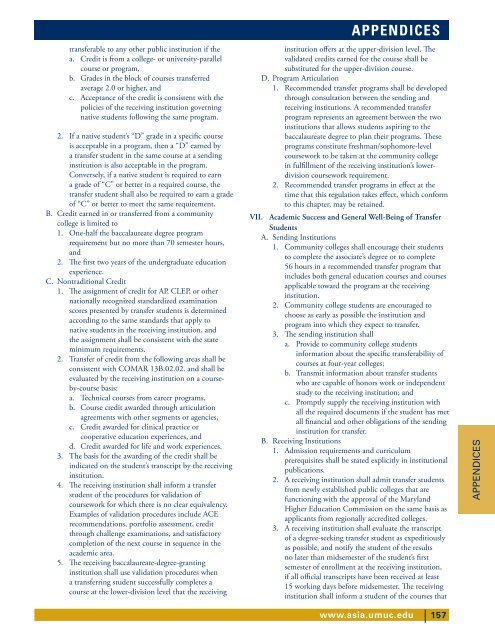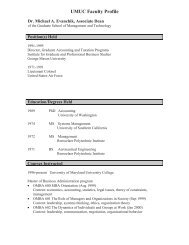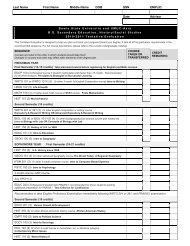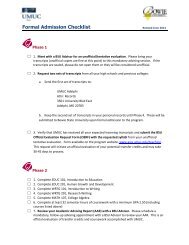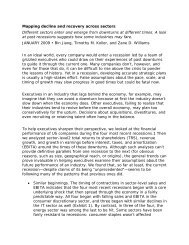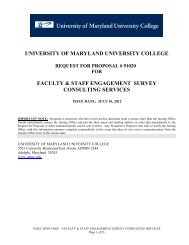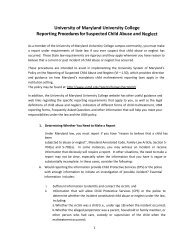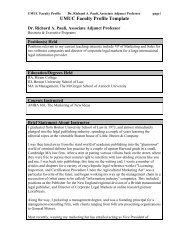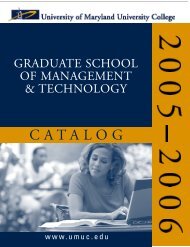welcome to UmUc - UMUC Asia - University of Maryland University ...
welcome to UmUc - UMUC Asia - University of Maryland University ...
welcome to UmUc - UMUC Asia - University of Maryland University ...
You also want an ePaper? Increase the reach of your titles
YUMPU automatically turns print PDFs into web optimized ePapers that Google loves.
transferable <strong>to</strong> any other public institution if the<br />
a. Credit is from a college- or university-parallel<br />
course or program,<br />
b. Grades in the block <strong>of</strong> courses transferred<br />
average 2.0 or higher, and<br />
c. Acceptance <strong>of</strong> the credit is consistent with the<br />
policies <strong>of</strong> the receiving institution governing<br />
native students following the same program.<br />
2. If a native student’s “D” grade in a specific course<br />
is acceptable in a program, then a “D” earned by<br />
a transfer student in the same course at a sending<br />
institution is also acceptable in the program.<br />
Conversely, if a native student is required <strong>to</strong> earn<br />
a grade <strong>of</strong> “C” or better in a required course, the<br />
transfer student shall also be required <strong>to</strong> earn a grade<br />
<strong>of</strong> “C” or better <strong>to</strong> meet the same requirement.<br />
B. Credit earned in or transferred from a community<br />
college is limited <strong>to</strong><br />
1. One-half the baccalaureate degree program<br />
requirement but no more than 70 semester hours,<br />
and<br />
2. The first two years <strong>of</strong> the undergraduate education<br />
experience.<br />
C. Nontraditional Credit<br />
1. The assignment <strong>of</strong> credit for AP, CLEP, or other<br />
nationally recognized standardized examination<br />
scores presented by transfer students is determined<br />
according <strong>to</strong> the same standards that apply <strong>to</strong><br />
native students in the receiving institution, and<br />
the assignment shall be consistent with the state<br />
minimum requirements.<br />
2. Transfer <strong>of</strong> credit from the following areas shall be<br />
consistent with COMAR 13B.02.02. and shall be<br />
evaluated by the receiving institution on a courseby-course<br />
basis:<br />
a. Technical courses from career programs,<br />
b. Course credit awarded through articulation<br />
agreements with other segments or agencies,<br />
c. Credit awarded for clinical practice or<br />
cooperative education experiences, and<br />
d. Credit awarded for life and work experiences.<br />
3. The basis for the awarding <strong>of</strong> the credit shall be<br />
indicated on the student’s transcript by the receiving<br />
institution.<br />
4. The receiving institution shall inform a transfer<br />
student <strong>of</strong> the procedures for validation <strong>of</strong><br />
coursework for which there is no clear equivalency.<br />
Examples <strong>of</strong> validation procedures include ACE<br />
recommendations, portfolio assessment, credit<br />
through challenge examinations, and satisfac<strong>to</strong>ry<br />
completion <strong>of</strong> the next course in sequence in the<br />
academic area.<br />
5. The receiving baccalaureate-degree-granting<br />
institution shall use validation procedures when<br />
a transferring student successfully completes a<br />
course at the lower-division level that the receiving<br />
appendices<br />
institution <strong>of</strong>fers at the upper-division level. The<br />
validated credits earned for the course shall be<br />
substituted for the upper-division course.<br />
D. Program Articulation<br />
1. Recommended transfer programs shall be developed<br />
through consultation between the sending and<br />
receiving institutions. A recommended transfer<br />
program represents an agreement between the two<br />
institutions that allows students aspiring <strong>to</strong> the<br />
baccalaureate degree <strong>to</strong> plan their programs. These<br />
programs constitute freshman/sophomore-level<br />
coursework <strong>to</strong> be taken at the community college<br />
in fulfillment <strong>of</strong> the receiving institution’s lowerdivision<br />
coursework requirement.<br />
2. Recommended transfer programs in effect at the<br />
time that this regulation takes effect, which conform<br />
<strong>to</strong> this chapter, may be retained.<br />
VII. Academic Success and General Well-Being <strong>of</strong> Transfer<br />
Students<br />
A. Sending Institutions<br />
1. Community colleges shall encourage their students<br />
<strong>to</strong> complete the associate’s degree or <strong>to</strong> complete<br />
56 hours in a recommended transfer program that<br />
includes both general education courses and courses<br />
applicable <strong>to</strong>ward the program at the receiving<br />
institution.<br />
2. Community college students are encouraged <strong>to</strong><br />
choose as early as possible the institution and<br />
program in<strong>to</strong> which they expect <strong>to</strong> transfer.<br />
3. The sending institution shall<br />
a. Provide <strong>to</strong> community college students<br />
information about the specific transferability <strong>of</strong><br />
courses at four-year colleges;<br />
b. Transmit information about transfer students<br />
who are capable <strong>of</strong> honors work or independent<br />
study <strong>to</strong> the receiving institution; and<br />
c. Promptly supply the receiving institution with<br />
all the required documents if the student has met<br />
all financial and other obligations <strong>of</strong> the sending<br />
institution for transfer.<br />
B. Receiving Institutions<br />
1. Admission requirements and curriculum<br />
prerequisites shall be stated explicitly in institutional<br />
publications.<br />
2. A receiving institution shall admit transfer students<br />
from newly established public colleges that are<br />
functioning with the approval <strong>of</strong> the <strong>Maryland</strong><br />
Higher Education Commission on the same basis as<br />
applicants from regionally accredited colleges.<br />
3. A receiving institution shall evaluate the transcript<br />
<strong>of</strong> a degree-seeking transfer student as expeditiously<br />
as possible, and notify the student <strong>of</strong> the results<br />
no later than midsemester <strong>of</strong> the student’s first<br />
semester <strong>of</strong> enrollment at the receiving institution,<br />
if all <strong>of</strong>ficial transcripts have been received at least<br />
15 working days before midsemester. The receiving<br />
institution shall inform a student <strong>of</strong> the courses that<br />
www.asia.umuc.edu 157<br />
Appendices


